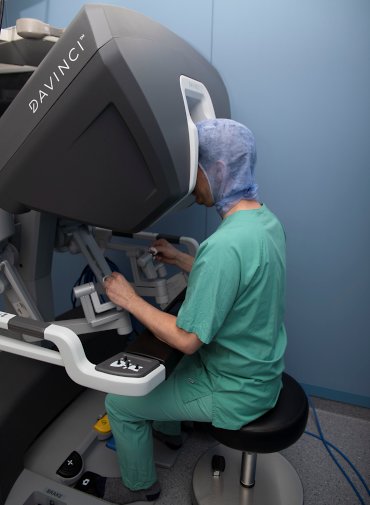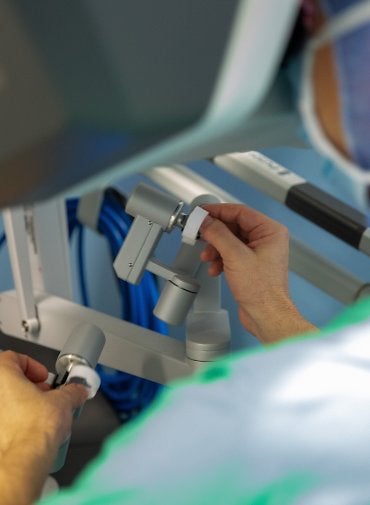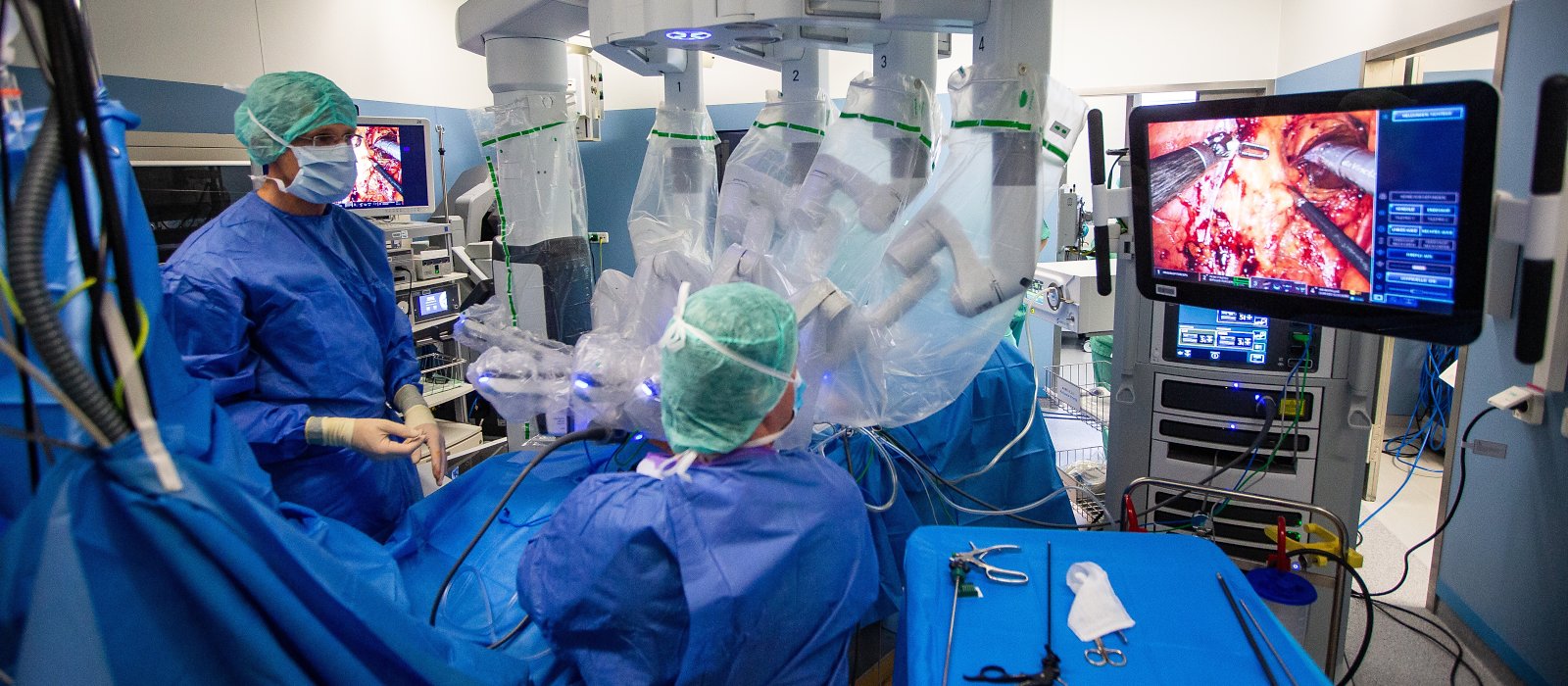
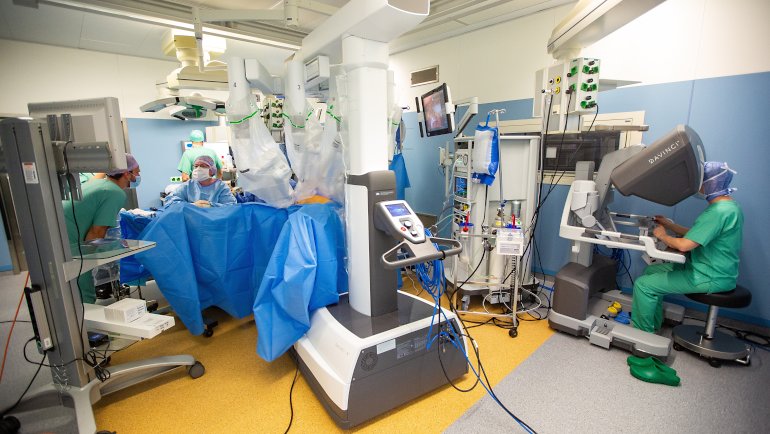
The robot arms move above the patient’s stomach as if guided by an invisible hand. Monitors on each side of the operating table show an oversized, 3-D image of the stomach’s interior. Two meters (about six feet) away, Dr. Markus Mille sits fully absorbed at the control console.
(Published: February 2021)
His hands are directing the movements of four robot arms: Three of them hold surgical instruments – scissors, forceps and tongs – while the fourth holds the camera that is transmitting the images from inside the stomach cavity. The doctor’s feet, meanwhile, are operating pedals that allow him to coordinate the robot’s actions and engage the individual arms. To get a better feel for what he is doing, he has removed his shoes.
The patient has colon cancer. Dr. Mille, Chief Senior Physician of the General and Visceral Surgery Clinic at Helios Hospital Erfurt under Chief Physician Prof. Dr. Albrecht Stier, starts by removing the tumor and a piece of the large intestine. He then reconnects the large intestine with the small intestine. To make space for the instruments between the abdominal wall and the organs, and perform what is known as a hemicolectomy, carbon dioxide has been injected to expand the stomach to twice its normal size.
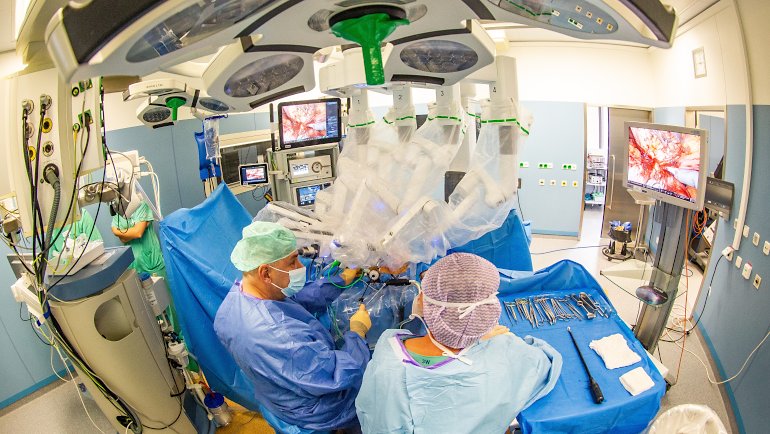
Robot-assisted surgery enables even more precision
In a consultation with Dr. Mille at the hospital in Erfurt, in the eastern German state of Thuringia, the patient opted to undergo the operation with the robot. “In cases like this,” the surgeon explains, “we can operate much more precisely with robot-assisted intervention – it’s easier on the patient and we can discharge them sooner from the hospital.” The surgical incisions are at most two centimeters – less than an inch – in length, and leave only small scars.
Using a robot in the operating room also has advantages for surgeons. The robot arms allow supple movements with a greater range of motion. This makes possible a more precise intervention than the conventional minimally invasive surgery, which uses fixed instruments. Surgeons assume a sitting position during the operation, which prevents weariness and back pain. In addition, the expanded monitor display of the area being operated on facilitates recognition of minute, delicate structures such as nerves and blood vessels.
“It is very impressive what can be achieved with the help of a robot. Now I am convinced: This is the future.”
The robot is called the da Vinci Xi, and costs about €2 million ($2.4 million). It is not capable of action on its own, but can perhaps best be described as an extended arm of the surgeon – one capable of neutralizing any shaking or vibrations of the hands. The surgical system consists of three components: The surgeon’s console, a patient cart – where the instruments are installed – and a so-called vision cart, which contains the computer devices that control communications between the components.
“The first time I heard about operating-room robots like these, I thought they were just some technical gimmick,” says Dr. Mille. “Then I immersed myself in the topic and undertook several study visits. It is very impressive what can be achieved with the help of a robot. Now I am convinced: This is the future.”
Before using the robot for the first time on a patient, the surgeon underwent weeks of comprehensive preparation with multiple training courses and study visits. Using computer simulation, he learned how to move the robot’s arms correctly, then traveled to a special robotics training center in Belgium to use the da Vinci Xi for the first time on a model.
“Stepping up to the operating table and just starting, which you may know from before, doesn’t work here,” Dr. Mille explains. “You must learn systematically how to handle the technology and deal with the different way of operating, and then train intensively.” The surgical team that works with the medical robots also received special training.
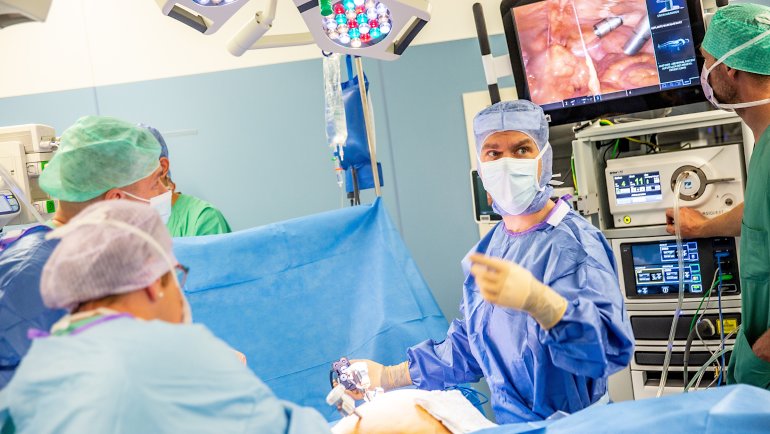
Use of robot-assisted surgery is growing
The colon surgery was Dr. Mille’s 88th surgical procedure using the robot. One operation that remains vivid in his memory was the removal of an 85-year-old patient’s esophagus: For this complex surgery, Dr. Mille – in a first in Thuringia state and at Helios – deployed the robot twice during the same procedure, once on the stomach and then in the chest area. Eight days later, the patient could leave the hospital.
In addition to General and Visceral Surgery, the robot is being used at Helios Hospital Erfurt in Gynecology, Thoracic Surgery and Urology. It can assist in surgery on various organs in the stomach, chest areas and pelvic areas, such as the lungs, liver, uterus or prostate.
Surgery is also being performed with da Vinci surgical systems at several other Helios hospitals, including in the German cities of Wuppertal, Schwerin, Krefeld, Duisburg and Aue. This is part of a larger trend in medicine: According to the manufacturer, more than 7.2 million operations were carried out with this surgical system in 2019.
Related Links
Making mistakes to avoid them A little heart at the center of a complex surgery Fresenius Helios Inpatient and Outpatient TreatmentsContact
Helios Kliniken GmbH
Friedrichstr. 136
10117 Berlin
Germany
T +49 30 521 321-0


